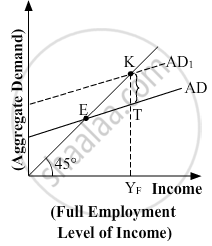Advertisements
Advertisements
Question
Answer the following question.
In the given figure, what does the gap 'KT' represent? State any two fiscal measures to correct the situation.

Solution
The gap 'KT' represents the inflationary gap. This is the situation of excess demand.
Fiscal policy refers to the policy that is undertaken by the government to influence the economy through the process of its expenditure and taxation.
The fiscal measures to correct the excess demand are given as follows:
- Government Expenditure: The Government of a country incurs various types of expenditure to enhance the welfare of the people and also to facilitate economic growth and development.
In case of excess demand, the government cuts down its expenditures in the form of disinvestment. This lowers the level of economic activity, which in turn, reduces the level of employment, thereby reducing the income level. This subsequently reduces the aggregate demand, thus, the situation of excess demand gets corrected. - Public Borrowings: Through the measure of public borrowings, the government affects the liquidity (cash balances) held by the public. It is because of the excess liquidity, the people demand more and vice-versa. Therefore, the government affects the liquidity balances with the help of public borrowings.
In the case of excess demand, the government raises public borrowings, which reduces the liquidity balances with the public. A reduction in the liquidity lowers the purchasing power of the people, which in turn, lowers the aggregate demand.
RELATED QUESTIONS
Fiscal deficit equals :
(a) Interest payments
(b) Borrowings
(c) Interest payments less borrowing
(d) Borrowing less interest payments
Suppose that for a particular economy, investment is equal to 200, government purchases are 150, net taxes (that is lump-sum taxes minus transfers) is 100 and consumption is given by C = 100 + 0.75Y (a) What is the level of equilibrium income? (b) Calculate the value of the government expenditure multiplier and the tax multiplier. (c) If government expenditure increases by 200, find the change in equilibrium income.
Consider an economy described by the following functions:- C = 20 + 0.80Y, I = 30, G = 50, TR = 100 (a) Find the equilibrium level of income and the autonomous expenditure multiplier in the model. (b) If government expenditure increases by 30, what is the impact on equilibrium income? (c) If a lump-sum tax of 30 is added to pay for the increase in government purchases, how will equilibrium income change?
Explain why the tax multiplier is smaller in absolute value than the government expenditure multiplier.
Does public debt impose a burden? Explain.
Are fiscal deficits inflationary?
Discuss the issue of deficit reduction.
Fiscal deficit = ______.
The primary deficit in a government budget is ______.
Which of the following statement is true?
Which of the following factors necessitated the need for economic reforms?
Assertion (A): Fiscal deficit is measured in terms of borrowings.
Reason (R): External borrowings increases the Fiscal deficit.
Which of the following statements are correct
Statement 1: Fiscal deficits are not necessarily inflationary; though, they are generally regarded as inflationary.
Statement 2: When the government expenditure increases and tax reduces, there is a government deficit and there will be a corresponding increase in the aggregate demand.
Which of the following statements is true?
Fiscal Deficit equals:
The shape of average revenue curve in monopoly is ______
How good is the system of G.S.T as compared to the old tax system?
